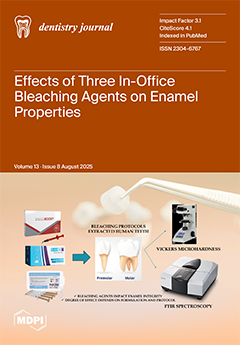Background: The present study investigated the relation between dental inclination, colorimetric variation, and aesthetic perception according to the modification of incisor inclination. Smile aesthetics, shaped by morphological factors and patient perception, are vital for social attractiveness and treatment success. This study aimed to assess the effect of varying head tilt on the perceived colour of upper central incisors by simulating changes in torque of the tooth, as well as evaluate factors influencing the perception of an aesthetic smile, including morphological characteristics and gingival aesthetic parameters.
Methods: The study was comprised of three stages: colour analysis, evaluation of micro- and mini-aesthetic smile features, and an image-based assessment to determine evaluator perceptions and overall smile attractiveness. A sample of 50 students with complete, lesion-free anterior dentition was analysed. To simulate the effect of orthodontic torque changes during colour analysis, subjects tilted their heads downward and upward, representing palatal and buccal crown torque, respectively. Standardized macro-intraoral photographs were captured under controlled lighting conditions using a DSLR camera stabilized on a tripod in the different positions: the neutral head position (
p0), 15° upward (
p + 15), and 15° downward (
p − 15). Digital colour analysis was conducted in the CIELAB colour space (L*, a*, b*). In the next stage, focusing on micro- and mini-aesthetic evaluation, an additional 50 smiles were generated using artificial intelligence via the SmileCloud program—one digitally enhanced smile per subject—complementing the initial set of 50 spontaneous smiles. These 100 smile images were evaluated by 50 laypersons and 50 dentists using a visual analogue scale via an online questionnaire, in order to assess perceptions, determine smile attractiveness, and quantify gingival aesthetic parameters.
Results: The statistically significant regression results are as follows: those for the L* values in all three head inclinations: downward (−15 degrees), upward (+15 degrees), and total tilting (−15 to +15 degrees), as well as for the a* values for downward tilting and the b* values for total tilting. When the head is tilted downwards, the central incisors are positioned retrusively, and the L* b* values reveal a darker and more yellowish appearance, whereas, with the head tilted upwards, the central incisors protrude, and L* a* values indicate a brighter and more greenish appear. In the evaluation stage of the smile aesthetics study, no significant differences were observed in the judgments between laypersons and dentists or between males and females. Smiles with a high or average anterior line, parallel arc, upward lip curvature, visible first/second premolars, a smile index of 5.08–5.87, and symmetry score of 1.04 were rated as more attractive. Significant asymmetries were observed between upper dental hemi-quadrants in gingival contour and interdental papilla height, highlighting subtle morphological variations relevant to smile aesthetics.
Conclusions: Aesthetic assessment revealed that the findings suggest a measurable impact of head position on dental colour perception and aesthetic evaluation. Evaluator variables including profession and gender exerted negligible effects on aesthetic perception, whereas smile attractiveness features and gingival aesthetic parameters demonstrate significant clinical applicability in patient management.
Full article






